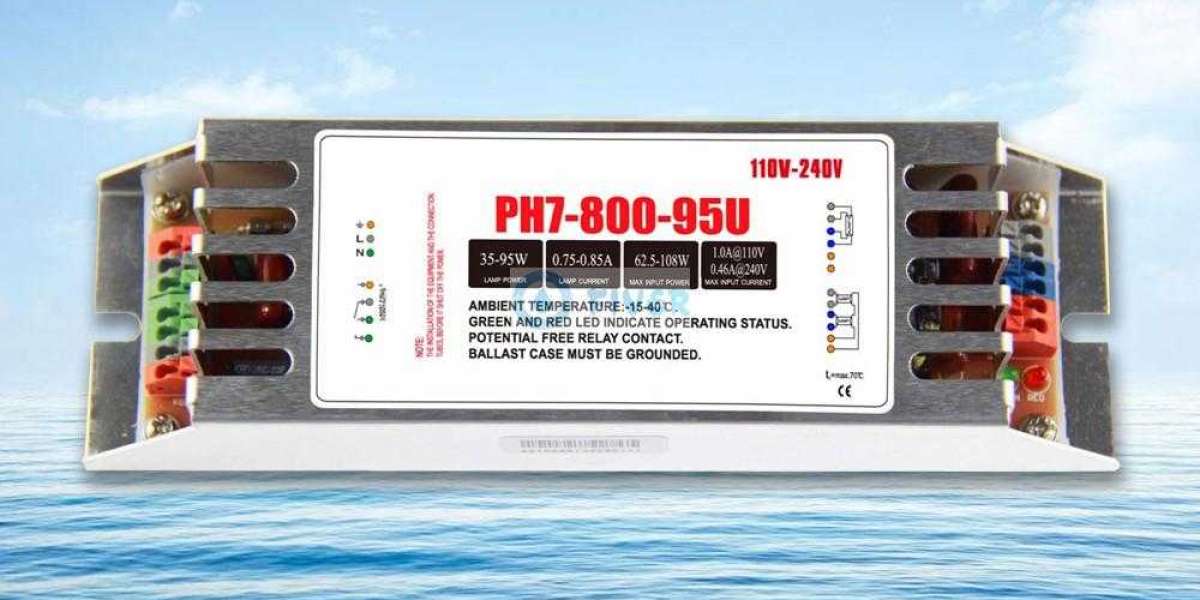Ultraviolet (UV) technology is at the forefront of modern disinfection and purification systems. From water and air sterilization to surface treatment and medical applications, UV light plays a crucial role in eliminating harmful microorganisms. But to ensure that UV lamps operate efficiently and reliably, they require a vital supporting component—UV electronic ballasts.
In this comprehensive guide, we will explore everything you need to know about UV electronic ballasts—what they are, how they function, their advantages over traditional ballasts, applications, and how to select the best one for your system.
What Are UV Electronic Ballasts?
UV electronic ballasts are advanced control devices that regulate the voltage and current supplied to ultraviolet lamps. Unlike magnetic ballasts, which use coils and iron cores, electronic ballasts use solid-state circuitry to provide precise and efficient power control. This allows UV lamps to perform with optimal stability and longevity.
These ballasts are specially designed to start UV lamps quickly, maintain consistent operation, and protect the lamp and the system from electrical damage.
Why Are UV Electronic Ballasts Important?
UV lamps are highly sensitive to fluctuations in voltage and current. Without a proper ballast, these lamps might:
- Fail to start
- Flicker or hum
- Overheat or burn out prematurely
- Deliver inconsistent UV intensity
UV electronic ballasts eliminate these problems by delivering a stable power supply tailored to the requirements of the lamp. They are especially important in high-performance UV systems used in hospitals, laboratories, water treatment plants, and commercial HVAC systems.
How Do UV Electronic Ballasts Work?
The working of an electronic ballast involves multiple stages:
1. Preheating or Starting the Lamp
Upon switching on, the ballast supplies a high-voltage pulse to ignite the UV lamp. Some models offer preheating functionality to extend lamp life.
2. Current Regulation
Once the lamp is ignited, the ballast stabilizes the current, allowing for continuous and flicker-free operation. The electronic circuit adjusts the current flow to prevent overdriving or underpowering the lamp.
3. Shutdown Protection
Many UV electronic ballasts are designed with safety mechanisms to detect lamp failure, overheating, or voltage surges. In such cases, the ballast may shut down to prevent damage.
Advantages of UV Electronic Ballasts
Electronic ballasts offer several benefits over older magnetic ballasts, especially in UV applications:
✅ Higher Energy Efficiency
Electronic ballasts consume less power and reduce energy loss, helping you cut down on operational costs.
✅ Longer UV Lamp Life
Stable current and reduced start-up stress prolong the lifespan of UV lamps, saving money on replacements.
✅ Compact Size and Lightweight
Their smaller size makes them ideal for tight installations and lightweight systems.
✅ Instant Start and Quiet Operation
No flickering or warm-up delays. Electronic ballasts offer silent and smooth performance.
✅ Thermal Protection and Self-Diagnostics
Advanced features protect the system and offer easy troubleshooting in case of faults.
Applications of UV Electronic Ballasts
Thanks to their efficiency and precision, UV electronic ballasts are widely used in a range of industries and environments:
1. Water Purification Systems
UV ballasts are used in residential and industrial UV water sterilizers to eliminate bacteria, viruses, and protozoa without chemicals.
2. Air Disinfection (HVAC UV Systems)
Electronic ballasts regulate UV lamps inside HVAC ducts and air purifiers, improving indoor air quality by destroying airborne pathogens.
3. Surface Sterilization
In hospitals, food processing plants, and laboratories, UV-C systems disinfect workstations, equipment, and packaging areas.
4. Aquariums and Ponds
UV sterilizers for aquariums and koi ponds rely on electronic ballasts to operate continuously and prevent algae or microbial growth.
5. Medical and Pharmaceutical Facilities
Cleanroom environments demand reliable UV disinfection powered by precise ballast systems to meet hygiene standards.
Types of UV Electronic Ballasts
Electronic ballasts are designed to meet specific operational needs. Here are the most common types:
? Single Lamp Ballasts
Designed for systems with only one UV lamp. These are common in residential and small-scale units.
? Multi-Lamp Ballasts
Support multiple lamps simultaneously. Used in large air or water treatment systems.
? Dimmable Ballasts
Allow users to control UV output. Useful in environments where UV exposure must be carefully controlled.
? High-Frequency Ballasts
Operate at frequencies above 20kHz. They reduce flickering and provide smoother operation.
Key Features to Look for in UV Electronic Ballasts
When selecting a UV electronic ballast, consider the following essential features:
1. Lamp Compatibility
Make sure the ballast is compatible with the specific type (amalgam, low-pressure, medium-pressure) and wattage of your UV lamp.
2. Voltage Range
Some ballasts are universal (120V-277V), while others are specific to certain power inputs. Check what’s supported.
3. Environmental Protection
If the ballast will be installed in humid, wet, or outdoor conditions, look for sealed, waterproof, or ruggedized models.
4. Certifications
UL, CE, RoHS, and NSF certifications ensure that the ballast meets safety and quality standards.
5. Built-in Safety Features
Thermal shut-off, lamp fault detection, and end-of-lamp-life shutdown are valuable features.
Maintenance Tips for UV Electronic Ballasts
Although electronic ballasts require minimal maintenance, a few practices can ensure long life:
- ? Regular Inspection – Check for signs of overheating, discoloration, or noise.
- ? Dust Removal – Keep the unit clean and free of dust buildup to prevent heat issues.
- ? Check Connections – Ensure lamp and power connections are tight and corrosion-free.
- ? Replace as Needed – If the ballast shows failure signs (e.g., lamp not starting, humming sound, flashing), replace it promptly.
Signs Your UV Electronic Ballast Is Failing
Watch out for these indicators that a UV electronic ballast may be going bad:
- ⚠️ UV lamp flickering or not turning on
- ⚠️ Ballast feels excessively hot
- ⚠️ Unusual buzzing or humming noises
- ⚠️ Burnt smell or visible damage
- ⚠️ System shuts down without warning
Top Brands for UV Electronic Ballasts
Several reputable manufacturers produce high-quality UV electronic ballasts:
- Advance by Signify (Philips)
- Keystone Technologies
- Fulham Lighting
- Viqua (Trojan Technologies)
- GE Lighting
- OSRAM Sylvania
Always source from certified distributors or OEM suppliers to ensure authenticity and warranty protection.
Conclusion: Why UV Electronic Ballasts Matter
UV electronic ballasts are the heart of modern UV disinfection systems. Their ability to efficiently start, regulate, and protect UV lamps is critical for system performance, energy savings, and effective microbial control.
Whether you’re upgrading an existing system or designing a new one, choosing the right ballast will make all the difference in reliability and safety. With many options available, be sure to consider lamp compatibility, environmental conditions, voltage requirements, and certification standards before making your choice.



